Member
Joined 2009
Paid Member
The nerd inside reminds me that even Silicon is 99% vacuum, those atoms are pretty much much empty 🙂What was that thing someone had said, and I'm going to paraphrase, "Electrons are much happier flying through vacuum than being shoved through doped silicon."
Member
Joined 2009
Paid Member
I realize now that I, as usual, somehow managed to miss to get to the point in my first post. The "artistry vs engineering" part in the title was a reference to something Pete Millett mentions on his web page: He calls his DCPP amp "the engineer's amplifier" while his 300B SET loaded with audiophile mojo is an "artist's amplifier". There is something about the open distinction between engineering and artistry that I find a bit fascinating, it would be interesting to hear some reflections on this.
I have observed that audio has an "uncanny valley" effect similar to computer graphics.
In CGI, animated characters are made to look cartoon-like rather than realistic because being too close to real will make movie viewers uncomfortable. Viewers expect to see either real humans or cartoon characters.
In audio, reproduced sounds becoming too close to real will throw listeners off. An audio system either has to produce sound indistinguishable from the musical instruments, or produce an obvious reproduction.
Ed
In CGI, animated characters are made to look cartoon-like rather than realistic because being too close to real will make movie viewers uncomfortable. Viewers expect to see either real humans or cartoon characters.
In audio, reproduced sounds becoming too close to real will throw listeners off. An audio system either has to produce sound indistinguishable from the musical instruments, or produce an obvious reproduction.
Ed
Nobody has answered the question. Yes, we are all nutz. I would like to think we are all hooked on artistry and engineering as well.
Thanks, thats what I really wanted to hear. Feels good not to be alone 😀Yes, we are all nutz.
The only way to "save" any money that I can think of here is when you want a specific piece of gear and decide to build a clone/kit version of it instead of a buying one. In the end there wonät be any money saved that way either, this stuff is addictive and no one quits after building one amp...
In local audio community here, they have opinion that LM1875 is not good enough metal music or complex instruments music.
Timbre is subjective if there is no comparison. So, usually we search good stereo imaging first, and second sound like live (unplug) instruments.
If you feel your sound system is only good for specific genre of music, there must be something wrong.
Timbre is subjective if there is no comparison. So, usually we search good stereo imaging first, and second sound like live (unplug) instruments.
If you feel your sound system is only good for specific genre of music, there must be something wrong.
Nuts? Of course not. Everybody knows one amplifier is not enough. You need at least ten. And you buy as many tubes as possible because you never know when one might fail. So now I have more than 30 amps and enough material to build amps filling two life times; I have survived at least 10 lethal shocks.
I once was working on an amp and thought it would be better to turn it around but forgot it was still attached to the mains (230 v) so I happened to grab the mains transformer and couldn't come loose (thanks to the 50hz we have here). It took about 7 seconds ( I saw glitters everywhere) then I managed to turn around so the amp fell on the floor. I phoned my wife to say I would be a little later. I never realized the number of muscles one has in the upper body (the cramps!). And has that stopped me? Certainly not! Nuts in the eyes of whom? I know a few examples but bet you can fill this in for yourself....
I once was working on an amp and thought it would be better to turn it around but forgot it was still attached to the mains (230 v) so I happened to grab the mains transformer and couldn't come loose (thanks to the 50hz we have here). It took about 7 seconds ( I saw glitters everywhere) then I managed to turn around so the amp fell on the floor. I phoned my wife to say I would be a little later. I never realized the number of muscles one has in the upper body (the cramps!). And has that stopped me? Certainly not! Nuts in the eyes of whom? I know a few examples but bet you can fill this in for yourself....
Damn, I'm way behind, need to go nuts!You need at least ten.
Most valve amplifiers wear their components like an exoskeleton, and a lot of planning and anguish is expended on the presentation; when it all comes together it transcends a simple construction and becomes something more.There is something about the open distinction between engineering and artistry that I find a bit fascinating
Much like a pile of bricks stacked in a particular way is worthy of centre stage in The Tate art gallery 🙂
LED lights exist,
But where I sit, read or write I want incandescent tungsten at 10x the electricity cost.
There's a difference, no matter how similar what you get on the other side of the prism or diffraction grating is.
And in winter I'm burning logs instead.
But where I sit, read or write I want incandescent tungsten at 10x the electricity cost.
There's a difference, no matter how similar what you get on the other side of the prism or diffraction grating is.
And in winter I'm burning logs instead.
I have more than ten, but less than half of them are completely built and fully functioning. A year or so ago I realized that some of my amps including the first ever SSE, the 300 Beast, and the 845SE had not seen power since I left Florida 10 years ago. They were sold or parted out. I will probably keep the original Lexan TSE forever since it was the first ever Tubelab amp, but it has not seen power in a long tine either.You need at least ten.
Engineering - The act of planning out an amp build in advance, designing the circuit, simulating the results, tweaking the simulation to achieve the desired results, doing simple electrical experiments to verify proper operation of some circuits or concepts that don't simulate easily before committing to the final build. The "tone," that fine balance between signal and distortion found in most guitar amps is impossible to simulate accurately, since "tone" is not a definable or even measurable quantity. The next steps usually involve ordering all of the parts, then planning and executing the build. Since everything was well planned and executed, the result should be a nice looking amplifier that works great at first power up and will remain untouched forever..........NOT!
Artistry - The act of sitting down with the less than nice looking, non working collection of parts that you just created with a soldering iron that didn't quite perform as expected and a much larger pile of uncommitted parts. It could also start from ai idea and a pile of uncommitted parts, and then hacking it all into something that performs a useful or semi useful function. True perfection may never be achieved, but the "work of art" continues to evolve, often involving long periods of inactivity. This process involves connecting said collection of parts together to create something useful, but not always exactly the "something" that you envisioned when starting the project.
Reality - A person who is good at building stuff will usually have skills from both disciplines. My venture into vacuum tube electronics started at a young age. Parts were essentially free since a kid in the late 50's / early 60's didn't have to look far to find a discarded radio or TV set. Knowledge pertaining to what to do with these parts was a bit more difficult. Internet?.......not even a dream yet since the PC as we know it was still 20 years away. A local ham radio guy introduced me to the ARRL handbooks, gave me an old one and an old tube manual. School libraries were useless, and the county library wasn't much better. Skipping the school lunch and spending my lunch money on electronics related magazines was the best info source I had. A school mate had and old Fender Champ guitar amp that just happened to die while I was at his house. I did not even know that his older brother could fix electronic stuff, but he took it apart, changed a few parts, and put it back together. During this process, I wound up with a hand traced schematic of a 1950's vintage Fender Champ 5C1, and I was on a mission to build one. About a year later I had three octal sockets, two transformers robbed from old radios, and a few other parts all screwed to a pine board. I could plug my guitar and a box full of speakers into it and make noise! Anyone else remember Fahnestock Clips? Screw a bunch of them to a board and make a complete amp without soldering.
I now know just how little I knew about electronics and vacuum tubes back then. Load lines, never heard of them. Impedance, yeah that's the number written on the back of a speaker......Impedance matching, OK, your OPT is supposed to match that number, but none of my salvage transformers had meaningful numbers on them. It didn't seem to matter much since most of my amps seemed to work. That realization came when I got into a 3 year vocational electronics program in high school. I spent two years in TV, radio, and consumer electronics repair before walking into a Motorola plant and getting a real job. I changed jobs within Motorola whenever I didn't like what I was doing or got bored.
During my 41 years there I collected two engineering degrees at Motorola's expense, and finally landed a perfect fit job where I stayed for the last 14 years of my career. I joined a research group that invented or designed new technology for two way radio equipment. There were lots of highly educated people there who lived at the screen of a simulator. Custom IC chip design REQUIRES lots of this kind of work. Many of these "pure engineering" people had no idea how to solder or lay out a PC board. A new IC chip takes about 1 MILLION DOLLARS and two years to go from concept to "first silicon." There are often several interim test chips created along the way to test and verify operation of a new concept, circuit, or technology. Someone needs to take those test chips, the first silicon, and subsequent clean up passes and turn them into something that high level management can see, hear, and touch to justify the serious expense.
I was that someone. That does not make me a "purely artistic" designer, I just have no desire to sit at a computer all day. I want to make something. I designed and built test boards that were fully functioning two way radios featuring our chips. I always had one sitting on a nearby workbench tuned into the local police department, or the distant Miami PD since they were much more interesting to listen to since there was nearly one murder a day in Miami at the time. Prior to my "fully functional radio" boards test boards or EValuation Boards (EVB's) were just used to fill spreadsheets with data that the money people do not understand. Cops speaking to each other coming from a small speaker on a large board full of parts and one of the latest chips in a test socket gets attention. Having a big red "TRANSMIT" button on that EVB with a warning NOT to push it got LOTS of attention, though I never had it enabled unless I was testing transmit functions on a dead frequency without an antenna. My workbench was often the first stop when the "Suits from Schamburg" were in town. Yeah, a bunch of highly paid suits show up in Florida and their first stop is to go see the guy in flip flops and a T-shirt! That really annoys the "pure engineers" and some of the managers.
The fine balance of the two extremes presented above can be illustrated in a few pictures.
Back in 2011 someone had joined the diyAudio forums chiefly to attempt to advertise a guitar amp kit that he was selling on Ebay. He started out by coming to a forum that is frequented by people who like to build things and saying ," Only 69.95 COMPLETE! (Except for the speaker and the chassis)......You can't build a guitar amp for less than this. Not no way. Not no how." This act led to the "Hundred Buck Amp Challenge" and the creation of several different low cost guitar amps. The entire challenge is now a sticky in the Amps and Instruments section of the forums here:
UPDATE:
Since this thread had pretty much run its course, the rules were loosened in early 2016:
Nobody is enforcing the rules any more. This thread was about making a playable guitar amp for a budget of $100. Unless anybody cares, maybe it should now be about an amp you would really want to use for minimum $$$$. Several good ideas were spawned here and a few amps were made. How many of those amps still get used?
Back then, several compromises were made in our designs to fit the budget. Now that we aren't constrained, we can use the parts we like to get the tone we want...Bring on the...
Since this thread had pretty much run its course, the rules were loosened in early 2016:
Nobody is enforcing the rules any more. This thread was about making a playable guitar amp for a budget of $100. Unless anybody cares, maybe it should now be about an amp you would really want to use for minimum $$$$. Several good ideas were spawned here and a few amps were made. How many of those amps still get used?
Back then, several compromises were made in our designs to fit the budget. Now that we aren't constrained, we can use the parts we like to get the tone we want...Bring on the...
- bst
- Replies: 2,202
- Forum: Instruments and Amps
In the original contest the designer of the $69 amp mandated that no silicon could be used anywhere except the power supply diodes because that was HIS definition of a "tube amp." I made three different amps for that challenge, all of which satisfied those requirements. The smallest one cost about $50 to build. The circuit was designed mostly by lifting ideas from popular guitar amp designs, implementing them with series heater string tubes that were common in old "AA5" radios. The first iteration used a small isolation transformer for power and a PCB mount 2 X 120 volt to 2 X 6.3 volt transformer for the OPT. 5 tubes were used. All were (and still are) in the $1 or less per tube price range. Crude sky - wiring of the flying parts on the bottom side of the board was used to test ideas. Several iterations of "Amp 1.0" evolved into a playable design but I was never satisfied with it. This morphed into a 4 tube design called "Amp 1.2" which got committed to a PC board layout. The 6.3 volt transformer that was the OPT got swapped for a 70 volt line matching transformer from Parts Express and a crude chassis and cabinet was made. Amp 1.2 was the low cost leader in the challenge.
I used it for a while, but I really was not into the sound it made, so......it gets ripped up again! Parts started growing all over the existing PCB. Since the challenge had ended and there were no rules, some three legged silicon based life forms made their way onto the bottom of the PCB. Things were improving, it started to ROCK! I wound up connecting another pot into the design with clip leads. This control varied the gain of the input stage from about 2 X to about 500 X. There was more gain available, but pentode tubes become highly microphonic at this gain level. I tinkered with parts, clip leads, and used 4 different guitars before arriving at a design I liked. The next step was obvious, time to make another PCB. It turned out pretty ugly but worked fine. It's still in the amp and still works after 9 years of abuse. I made a suitable chassis using a pre-made metal box from Hammond.
This has been the only working guitar amp that I have used for 9 years, but it's time to make a new one with zero restrictions and every possible feature that I think I might want for the rest of my life......pretty lofty goals? OK, maybe more than one amp! Got to start somewhere, and that is usually the hardest part, just figuring out what to build.
Attachments
-
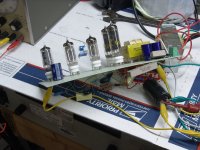 DSC00801.JPG478.4 KB · Views: 80
DSC00801.JPG478.4 KB · Views: 80 -
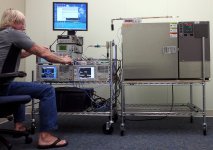 TempTestSetupLarge.jpg472.3 KB · Views: 76
TempTestSetupLarge.jpg472.3 KB · Views: 76 -
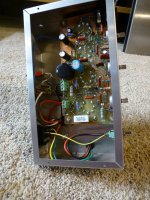 Chassis_4.jpg606.6 KB · Views: 73
Chassis_4.jpg606.6 KB · Views: 73 -
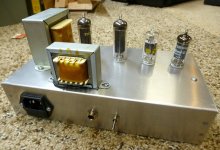 Chassis_3.jpg519.9 KB · Views: 74
Chassis_3.jpg519.9 KB · Views: 74 -
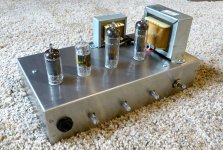 Chassis_1.jpg619.6 KB · Views: 74
Chassis_1.jpg619.6 KB · Views: 74 -
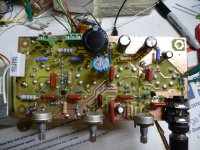 P1050285.JPG538.7 KB · Views: 74
P1050285.JPG538.7 KB · Views: 74 -
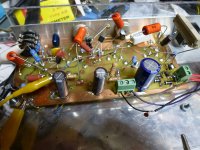 P1050284.JPG473 KB · Views: 71
P1050284.JPG473 KB · Views: 71 -
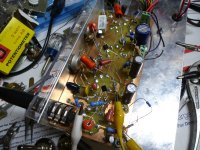 P1050283.JPG589.7 KB · Views: 73
P1050283.JPG589.7 KB · Views: 73 -
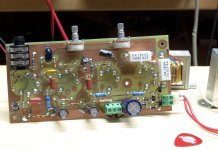 Bottom.jpg416 KB · Views: 83
Bottom.jpg416 KB · Views: 83 -
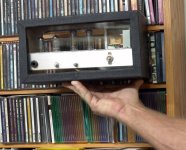 AlmostDone.jpg608.6 KB · Views: 81
AlmostDone.jpg608.6 KB · Views: 81 -
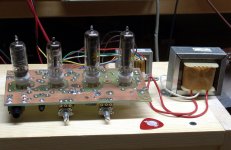 Testing.jpg450.5 KB · Views: 83
Testing.jpg450.5 KB · Views: 83
I have both Tube and SolidState amplification. In fair quantities... Oh, you already know this, @Fuling ! 😊😉
So you wont be surprised if I say that none is better than the other : just different, depending on how you use it, with what, and with which music !




But it's me, OK ?
T
So you wont be surprised if I say that none is better than the other : just different, depending on how you use it, with what, and with which music !
But it's me, OK ?

T
I really enjoy reading everyones responses here (and of course the nice pictures) even though I'm still not perfectly clear what it was I asked in the first post. "Are we just nuts?" We're gathered here in the Tube section, doesn't that answer that question already...? 😀
Anyways, back to the work bench (kitchen table...). I'm busy reinventing the Triadyne, a compound triode circuit from ~1935. I'm getting interesting results from a 12B4A driving a TZ20 with some local feedback involved, and it seems to be some kind of interesting distortion cancelling going on here as a bonus.
Anyways, back to the work bench (kitchen table...). I'm busy reinventing the Triadyne, a compound triode circuit from ~1935. I'm getting interesting results from a 12B4A driving a TZ20 with some local feedback involved, and it seems to be some kind of interesting distortion cancelling going on here as a bonus.
Just idle curiousity on my part...
With tube amps, the tubes/valves offer a warm, rich and harmonically diverse tone and sound quality. When you crank the gain or increase the volume of a tube amp, the sound produced by the valves breaks up and provides the harmonic distortion that guitarists covet. This is what's known as natural distortion.Oct 31, 2022
With tube amps, the tubes/valves offer a warm, rich and harmonically diverse tone and sound quality. When you crank the gain or increase the volume of a tube amp, the sound produced by the valves breaks up and provides the harmonic distortion that guitarists covet. This is what's known as natural distortion.Oct 31, 2022
- Home
- Amplifiers
- Tubes / Valves
- Artistry vs. engineering, or: Are we just nuts?